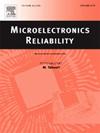氮化硼通孔的信号完整性和传热性能
IF 1.6
4区 工程技术
Q3 ENGINEERING, ELECTRICAL & ELECTRONIC
引用次数: 0
摘要
硅插层因其良好的介电性能和成熟的工艺,被广泛应用于 2.5D 集成封装。然而,硅插层并不适用于大功率器件和射频器件,存在信号完整性差和热传导效率低的问题。在这项工作中,c-BN 被用作中间膜,为器件的电信号干扰和热聚集提供了解决方案。此外,还对聚四氟乙烯、玻璃和 h-BN、w-BN 进行了比较研究。有限元模拟结果表明,在 40 GHz 时,TBV (c) 的回波损耗比 TSV 低 3.3 dB。TBV (c) 的插入损耗比 TSV 高 0.12 dB。在信号完整性方面,c-BN 内插件的性能优于硅内插件,与玻璃内插件的性能相似。RLGC 分析模型验证了有限元仿真的准确性。TBV (c) 的回波损耗会因插层厚度减小、铜柱间距增大或铜柱半径增大而减小。由于 c-BN 具有高热导率,TBV(c)的水平和垂直等效热导率约为 TSV 的 8 倍。TBV (c) 的散热性能也优于 TSV。TBV (c) 夹层在电气和热传导方面都具有优势,这为 2.5D 集成封装中的器件开发提供了新的前景。本文章由计算机程序翻译,如有差异,请以英文原文为准。
Signal integrity and heat transfer performance of through-boron nitride via
Silicon interposer is widely used in 2.5D integrated packages due to its good dielectric properties and mature process. However, silicon interposer is not suitable for high-power devices and radio frequency devices, suffering from poor signal integrity and low thermal conduction efficiency. In this work, c-BN is used as an interposer to provide a solution for electrical signal interference and thermal aggregation in the devices. In addition, PTFE, glass and h-BN, w-BN have also been studied for comparison. The finite element simulation results show that the return loss of the TBV (c) is 3.3 dB lower than that of the TSV at 40 GHz. The insertion loss of TBV (c) is 0.12 dB higher than that of TSV. The c-BN interposer performs better than the silicon interposer in terms of signal integrity, with a similar performance to the glass interposer. The accuracy of the finite element simulation is verified by the RLGC analytical model. The return loss of TBV (c) decreases due to the decrease in the interposer thickness, the increase in spacing between the Cu pillars or the increase in radius of the Cu pillars. Owing to the high thermal conductivity of c-BN, the horizontal and the vertical equivalent thermal conductivity of TBV (c) are approximately 8 times than those of TSV. The heat dissipation performance of TBV (c) is also better than that of TSV. The TBV (c) interposer shows advantages in both electrical and heat transfer aspects, which provide new perspectives for device development in 2.5D integrated packages.
求助全文
通过发布文献求助,成功后即可免费获取论文全文。
去求助
来源期刊

Microelectronics Reliability
工程技术-工程:电子与电气
CiteScore
3.30
自引率
12.50%
发文量
342
审稿时长
68 days
期刊介绍:
Microelectronics Reliability, is dedicated to disseminating the latest research results and related information on the reliability of microelectronic devices, circuits and systems, from materials, process and manufacturing, to design, testing and operation. The coverage of the journal includes the following topics: measurement, understanding and analysis; evaluation and prediction; modelling and simulation; methodologies and mitigation. Papers which combine reliability with other important areas of microelectronics engineering, such as design, fabrication, integration, testing, and field operation will also be welcome, and practical papers reporting case studies in the field and specific application domains are particularly encouraged.
Most accepted papers will be published as Research Papers, describing significant advances and completed work. Papers reviewing important developing topics of general interest may be accepted for publication as Review Papers. Urgent communications of a more preliminary nature and short reports on completed practical work of current interest may be considered for publication as Research Notes. All contributions are subject to peer review by leading experts in the field.
 求助内容:
求助内容: 应助结果提醒方式:
应助结果提醒方式:


